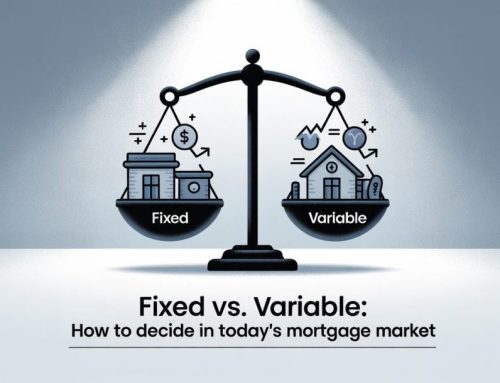The Bank of Canada is expected to start cutting their rate as soon as April 10th of this year. While it’s not certain, it sounds promising. The big six banks are all forecasting cuts between 1.00% and 1.75% by the end of this year, followed by further cuts in 2025.
When it becomes more apparent that the cuts will be imminent, fixed mortgage rates will drop in anticipation. They do not need to wait for the Bank of Canada to cut their rate.
For this reason, more are starting to ask about 1 year fixed rates, which currently range from 6.64% for an insured mortgage to 7.04% for uninsured.
By comparison, the lowest 3 year fixed rate ranges from 4.99% to 5.24% for the same categories. That’s a colossal difference of 1.65% to 1.80%!
The question is… will the gamble pay off?
No one can answer that question for sure without knowing exactly where rates will be in a year. All we can do is speculate and follow the forecasts by the economists. As we know, their track record hasn’t been the best over the last few years.
But what I can do is run the numbers to help you make the decision.
There are two things we need to consider:
1.The difference in cost between the two rates over the next 12 months.
2.The break-even rate – where the rate would need to be after 1 year to offset the difference in cost.
Comparing the Lowest 1 and 3 year Fixed Mortgage Rates
We’ll use a $500,000 mortgage with a 25 year amortization as an example, comparing a 1 year fixed rate at 6.64% with a 3 year fixed at 4.99%… the most popular term today. These rates are both available today for insured mortgages.
The difference in cost between these two rates is a whopping $8,179.60 after only 12 months. In other words, this is how much more you’ll owe at the end of the 1 year term if you choose that option. You can check out my blog on How To Calculate Savings Between Two Mortgage Rate Options which explains how this is calculated.
The break-even rate is 4.08%.
This is where the 2 year fixed rate will need to be at the end of the initial one year term for you to make up the more than $8K difference. The reason why a two year term is used is that, after the initial one-year term expires, there are still two years remaining to complete the three year term we are comparing it with.
But remember, this is only the break-even rate. It would need to be lower for you to come out ahead with the higher rate, shorter term option.
The 2 Year Fixed Mortgage Rate
By comparison, the lowest 2 year fixed rate is 5.79%, which would mean that it would need to come down by 1.71% after only 12 months. That’s a huge drop in a short amount of time. It’s possible that we could see this large of a drop. Possible. But that is far from a guarantee.
Remember, this is just to break even.
The question is… will the rate drop by more than 1.71% to actually put you ahead?
Making a Bet
Are you willing to bet $8,179 that the 2 year fixed rate will drop to 4.08% in 12 months… and just to break even?
Even if the rate drops below 4.08% after 12 months, the savings will only increase by roughly $490 until the end of the new two year term for every 0.05% it falls below the break-even rate.
Comparing the Lowest 1 and 2 Year Fixed Mortgage Rates
Now let’s compare the 1 year at 6.64% with the 2 year at 5.79% .
The break-even rate increases to 4.88%.
The difference after 12 months is $4,222.14.
But now since we are comparing a 1 and a 2 year term, there is only a 1 year difference between the two. This means that the 1 year fixed rate at the end of the first year would need to drop by 2.16% to 4.88% to earn back the $4,222 you were behind on the initial 1 year fixed rate. That’s a significant expectation. It’s a lot for the 5 year fixed rate to drop, let alone the 1 year.
Variable Rate Mortgages
The most popular term today remains the 3 year fixed, as it has the right combination of lower rate and shorter term. However, we’re getting close to the point where variable rate mortgages will start regaining popularity. If rates drop as expected, then it’s possible that you could still win with a variable rate. However, given that variable rate mortgages also carry substantial premiums, many are still shying away from them.
I’ll be discussing the feasibility of choosing a variable rate mortgage in today’s market in an upcoming blog. Until then, please reach out to us at pmteam@citycan.com or 647-368-5009 and we’d be happy to discuss your best options with you.
Variable rate mortgages currently range from prime -1.30% to prime -0.65%, depending on your situation (5.90% to 6.55%).
Conclusion
There were some people who chose 1 year fixed rates last year at this time for the reason they are looking at them today. They were expecting rates to drop substantially over the next year. However, they would have unfortunately paid a substantial rate premium given that rates are roughly around the same as where they were at this time last year. I would like to add that these were not any of my clients, as I would have talked them out of it by running these comparisons.
It’s looking more and more promising that rates will start to come down by this spring, but as always, nothing is certain, and anything can happen.
You’re essentially gambling a rather large sum of money that we will see extreme drops to fixed rates after only 12 months. For this reason, the majority of people feel most comfortable with 3 year fixed terms.








Leave A Comment